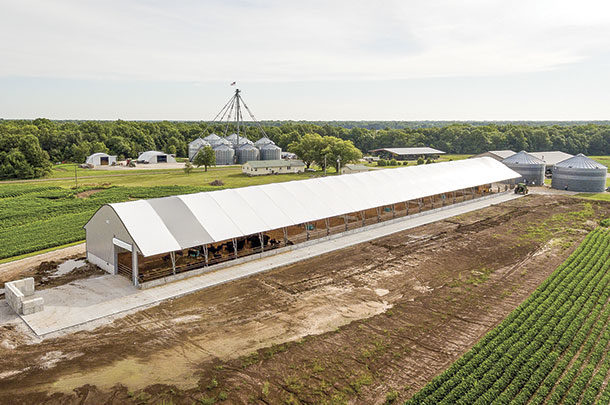In an already volatile industry, complete with weather, pest and disease pressures that can take away from a producer’s bottom line, being able to gain a little more control is an opportunity many cattle producers are taking advantage of.
Confinement cattle barns, which have gained in popularity over the past two decades, offer management solutions to many of the everyday challenges most producers face, including contained manure management, herd health, temperature control, and time and feed savings.
For Windsor, Missouri’s Ryan Hamilton of Hamilton Farms, a confinement barn was a solution to many of the management challenges and performance losses the operation had faced in recent years.
“This is our first barn, and what led us down this path was the cattle that have performed poorly in the terrible weather we have in this area. We think that this [confinement barn] is the best way to go in this area,” he says.
Currently, the Hamilton Farms operation consists of Ryan, his father and two full-time hired hands, who mainly work on the row crop side. Ryan and his father, Bill, manage the barn every day and both cite the time savings the barn provides as a major benefit.

From left, Bill Hamilton, Carla Hamilton, Michelle Hamilton, Ryan Hamilton, at the new facility during an open house event. Photo courtesy of Central Confinement Service LLC, Ginger Willard.
“Being able to save time by having everything in one location is just more efficient,” Ryan says.
He also shares that the initial driver in the decision to put the confinement barn in was the ability to calve indoors.
“Going into it [barn construction], we were looking mainly at a cow-calf operation,” he says. “We have always had mother cows outside to calve, and we thought that the barn would be a way to manage cows and calves in a controlled environment.”
After construction, however, the decision was made to shift from using the barn as a calving and calf-management unit to backgrounding. Today, the operation is backgrounding all of their own calves as well as purchased calves, with each group rotating out to a feedlot at 100 days weighing between 750 and 800 pounds.
“The biggest thing we were trying to accomplish by transitioning away from cow-calf to backgrounding was getting revenue flowing through the barn. The markets have been good to buy 450- to 500-pound calves; our biggest challenge with the barn is to not get them to weight too soon,” Hamilton says.
Designing for flexibility
The Hamiltons did their due diligence when deciding on a barn design, touring several cattle confinement barns in the Midwest.
“We looked at a lot of barns and, really, what brought us back to Central Confinement Services [CCS] was that they offered a complete turnkey package. They took care of everything from start to finish, and I didn’t have to find subcontractors. CCS handled everything and worked with us to design the barn the way we wanted,” Hamilton says.

The building features a working facility, fencing with creep gates, high-capacity waterers and a continuous bunk with a straight back feature for high volume and easy cleanout. Photo courtesy of Central Confinement Service LLC, Ginger Willard.
The option Hamilton chose was a 50-foot-wide-by-368-foot-long fabric covered Accusteel building that could house between 160 and 170 cow-calf pairs. The unit also features a high-back bunk system, made for high capacity, three-rail neck system and a power curtain for severe weather, and was constructed as a bed-pack, with a creep area, exterior loadout and Cancrete waterers.
The facility was also designed with convenience and versatility in mind, providing a full working facility and office space.
“Not much had to be changed to make the barn work for backgrounding and cow-calf,” Hamilton says. “The biggest thing we had to change around was the processing facility – how we handle cattle. We are bringing cattle in almost weekly and need to be able to get them worked and processed quickly.”
The design flexibility is something that Hannah Esch, marketing coordinator at CCS LLC, says is important to the team at CCS.
“If you’re unfamiliar with confinement barns, they have changed a lot,” she says. “They can be implemented to raise cow-calf or feed backgrounders or finish cattle in, and all of the barns work to maximize air flow to create a comfortable environment for the cattle.”

The facility makes working cattle easier and more efficient with two Bud boxes to facilitate low-stress work. Photo courtesy of Central Confinement Service LLC, Ginger Willard.
The air flow creates a cool and comfortable area for the cattle in the summer and a well-ventilated option to the weather elements in the winter that helps to minimize health issues. And for low-stress handling, the loadout area also features a Bud box.
“If an animal does get sick, you are within 300 feet of getting it treated,” Hamilton says of the health focus a confinement barn allows producers.
Highlighting innovation
On Aug. 13, 2020, CSS hosted an open house to showcase the new confinement facility at Hamilton Farms.
“The weather was perfect for the day,” Esch says, “and we had about 250 people turn out from Missouri and several surrounding states. It was great to be able to share the advantages a confinement barn can offer.”
Hamilton was also pleased with the turnout and happy to answer questions his neighbors and fellow producers had about the facility.
“We had a lot of questions during the open house, and we still have several neighbors asking us questions and wanting to come see it in action,” he says. “I think that most are giving us a little time to see how we like it before making the decision for themselves.”









